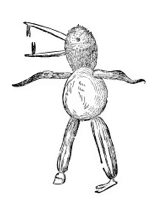I was smitten by this 2005 interview with Franck André Jamme, a French poet (John Ashbery translated one of his books) and anthropologist who has spent decades writing poetry and researching Tantric Art—not the Kami Sutra sexy stuff, but a particular Hindu practice that conjures representations of deities. Jamme's interview gives you the sense of how well he trusts his own instincts; he lets himself be led by his temperament: "I like to really compose a book, count a book like an exhibition, or a long piece of music with a beginning and an end. It is not at all a fiction but in fact a kind of mind story, you know, and you can't change the order of things." There's such good sense in that kind of certainty. Plus, I find Jamme's intentions so interesting. (Sometimes, when I read interviews, I find an artist's plans either dull or overblown.)
Two years after this 2006 issue of jubilat appeared, Wave Books published Jamme's book of poems, New Exercises. Because of the interview, I tracked down the book and spent several wintry days in its spell. I sat in a 1930s red chair with my feet propped and I felt as if I were cracking codes. And not metaphorically. I wasn't playing fantasy lit crit ball. No, I wasn't fooling with meaning at all. I was puzzling over the letters, the words.
Each of Jamme's poems is typeset in uppercase and arranged into squares or rectangles. No spaces are inserted between words. To decipher the piece, a reader's version of hunt and peck is in order:
TOSTOP
WONDER
INGWHA
TAWAIT
SUS
Pulling apart the words, I noticed, set the letters swimming and resettling. Soon, I was a child in the dentist's lobby, trying to find the word LOVE. After that, I felt like a crossword enthusiast though I've never liked crosswords. I was turning into a palindromic fanatic despite my resistance to word puzzles. Truthfully, I was merely trying to separate words so that I could read them, but something about the little alphabet lattices thrilled me for hours. Perhaps my fascination came from playing with language that remained only language for most of my engagement with it. Some squares were harder to decipher than others. As I worked, my mind heard the sound of its own voice.
Then the prize. Pop came the aphorism: "to stop wondering what awaits us."
In their cube forms, New Exercises are like modernist play chambers: clean and clear of clutter, shaking out well cut proverbs. They are games of fragment and utterance burnished in typeface.
Here's another one. As I look at it, I feel my own consciousness striding forward, hands on hips:
TOREFRAIN
FROMMEDIT
ATINGTOOL
ONGONIMAG
ESBRANDIS
HEDUPSIDE
DOWN
Brandishing anything upside down sounds like a good idea.
I loved the fortunes unwrapped, the Cracker Jack toys of Jamme's little fragments and riffs. Here are a few spelled out. Spoiler alert! "To end something by taking a planet from your pocket showing it and even making it spin," and "To desert endlessly the rooms of nostalgia."
What one has is the experience of holding, finally, is the aphorism's meat outside the shell. Delicious.
* * *
Here's the other inspiring thing I learned about our cube maker. Thirty years ago, Jamme was traveling on a bus through India. He was searching for Hindu Tantric painters who worked in meditative states to create physical manifestations of their deities. To see one of their paintings, some said, was to see what a god actually looked like. Though the style of imagery was traced back to the seventeenth century, the practice may have taken root hundreds of years earlier. Whenever the art originated, the paintings were surprisingly "modern" in composition. Jamme was eager to see what the living artists were making; he wanted to see how they brought forth the deities.
On route near Jaipur on that day in 1985, Jamme's bus collided head on with a truck. The accident left him in such bad shape that Jamme says he was transported back to France "in a hammock." Nine broken bones and several comas later, Jamme continued to write poetry from bed, but he didn't forget his search for the painters. He was haunted by them.
Twenty years later, after several trips back to India, Jamme finally found some of the Tantrikas who were constructing the beautiful, abstract pieces he'd longed to see. The artists worked anonymously and their work strangely resembled Modernist and Abstract Expressionist work. The paintings look simple and feel composed and completed within confines that do not bleed into the outer world. The images did not seem to represent the divine; they contained divinity itself.
In 2011, the painting ethnography that Jamee wrote and assembled, with images by some of the anonymous Tantrikas arrived: Tantra Song, published by Siglio. When I look at these images now, I am whispering Stevens, beholding the "nothing that is not there" along with "the nothing that is." One image might have an oval of orange; another holds an almond sweep of black or a white backdrop scraped with other colors. The paintings are both consciousness and transcendence. jubilat's interview with Franck André Jamme brought me to them.



